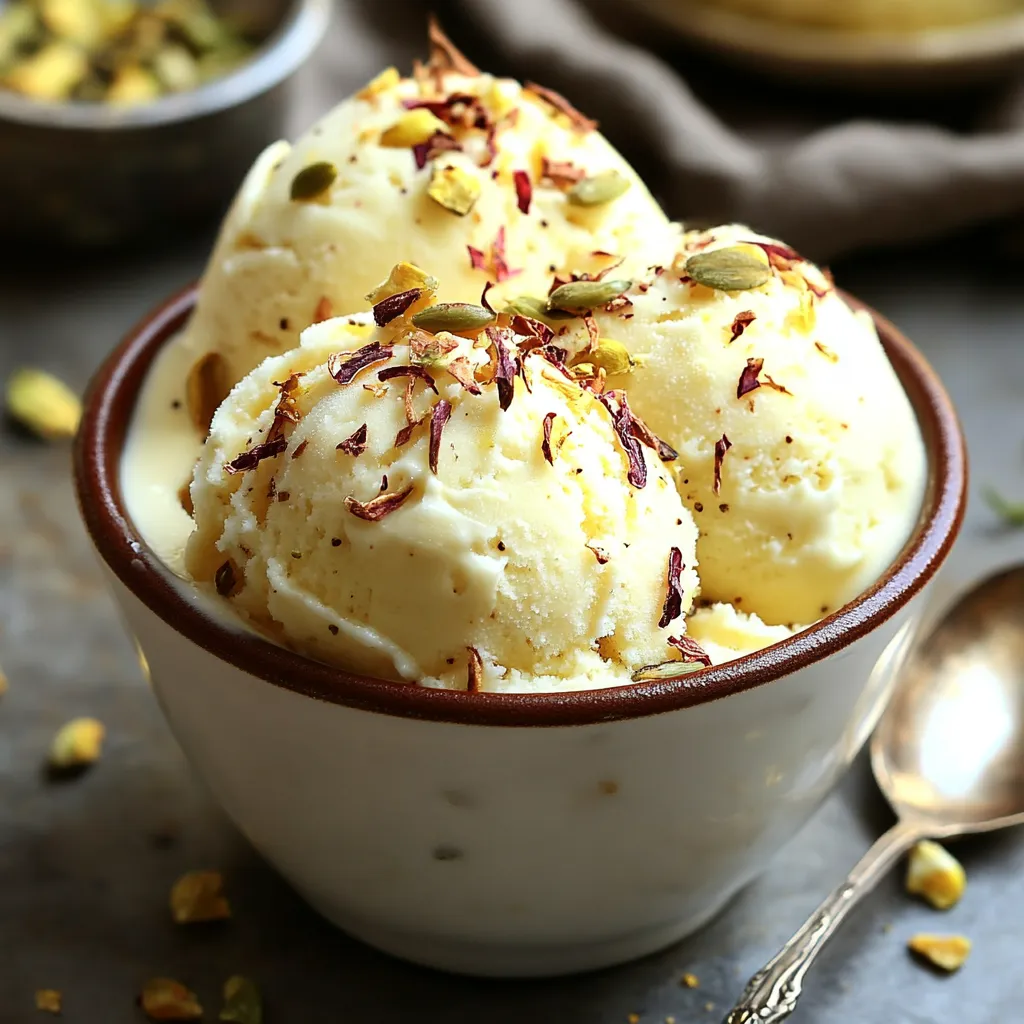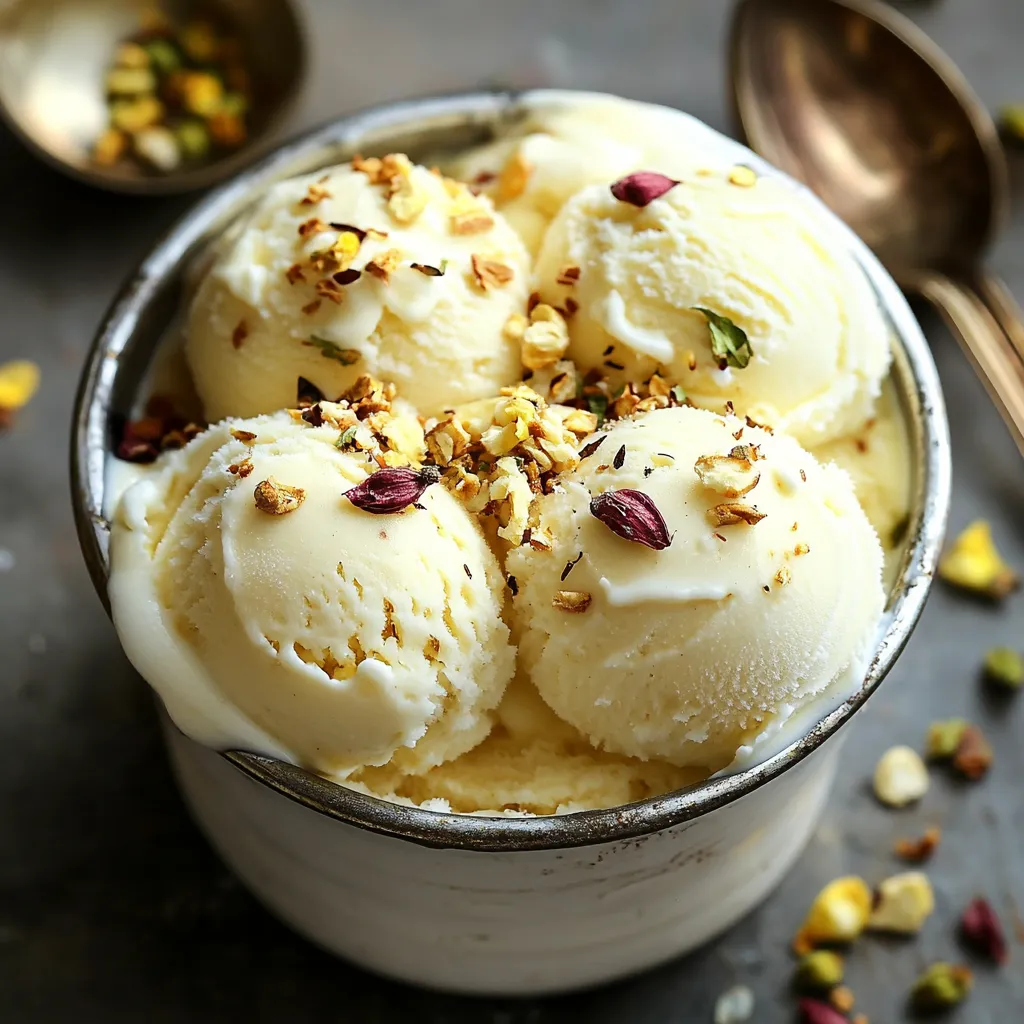 Pin it
Pin it
This creamy homemade kulfi ice cream brings the authentic taste of Indian desserts right to your kitchen. The slow-simmered milk creates that distinctive dense, creamy texture that sets kulfi apart from regular ice cream, while the aromatic blend of cardamom, pistachios, and almonds delivers the classic flavor profile loved across South Asia.
I first made this kulfi after returning from a trip to Delhi where I became obsessed with the street vendors selling these creamy frozen treats. After many attempts to recreate that distinctive texture and flavor, this recipe finally captured the essence of what makes kulfi so special.
Ingredients
- Full-fat milk: Forms the rich base of kulfi and must be simmered properly to develop flavor
- Evaporated milk: Adds concentrated dairy flavor without the extra sweetness
- Sweetened condensed milk: Provides both sweetness and creaminess to the dessert
- Heavy cream: Enriches the mixture further for that luxurious mouthfeel
- Sugar: Can be adjusted based on your sweetness preference
- Ground pistachios: Add the signature flavor and beautiful green flecks
- Chopped almonds: Provide texture and nutty depth
- Cardamom powder: Essential for authentic kulfi flavor
- Saffron strands: Give a subtle aroma and gorgeous golden hue
- Rose water: Adds a delicate floral note that complements the nuts perfectly
Step-by-Step Instructions
- Prepare the Milk Mixture:
- Combine full-fat milk and evaporated milk in a heavy-bottomed saucepan over medium heat. The heavy bottom prevents scorching as milk can easily burn. Stir frequently with a wooden spoon, making sure to scrape the bottom of the pan. Watch carefully as the mixture approaches a simmer—look for tiny bubbles forming around the edges but never allow it to reach a rapid boil.
- Add the Condensed Milk:
- Once you see those gentle bubbles forming, reduce your heat to medium-low. This is the crucial moment to add your sweetened condensed milk and sugar. Pour the condensed milk in slowly while stirring continuously to prevent any lumps from forming. Keep stirring until you can no longer feel sugar granules when you run your spoon across the bottom—about 2-3 minutes of constant stirring.
- Thicken the Mixture:
- This step requires patience and attention. Allow the mixture to simmer very gently for 15-20 minutes, stirring every few minutes to prevent skin formation or burning. You're looking for the mixture to coat the back of your spoon—if you run your finger through it, the line should hold. This reduction concentrates the flavors and creates that distinctive dense kulfi texture.
- Incorporate Flavorings:
- Remove from heat completely before adding the remaining ingredients. First stir in the heavy cream while the mixture is still warm, then add your ground pistachios, chopped almonds, cardamom powder, saffron strands, and rose water. The warmth will help bloom the spices and release their essential oils. Stir thoroughly for at least a minute to ensure even distribution of all the flavors.
 Pin it
Pin it
Cardamom is truly the heart of this recipe. I've tried making kulfi without it, and the result simply lacks that authentic character. I toast and grind my own cardamom pods whenever possible—the difference in aroma and flavor is remarkable compared to pre-ground powder. My grandmother taught me this trick, and it's one I'll never abandon.
Storage Tips
Kulfi can be stored in the freezer for up to a month if properly wrapped. First cover the surface with plastic wrap, pressing it directly onto the kulfi to prevent ice crystals, then seal the container tightly. For the best texture, allow kulfi to sit at room temperature for 5-10 minutes before serving. This slight softening makes it easier to scoop and enhances the flavor experience.
Serving Suggestions
In India, kulfi is traditionally served on a stick or unmolded onto a plate and cut into slices. For a modern presentation, serve scoops in small bowls garnished with crushed pistachios, a few saffron strands, and edible rose petals. For an indulgent dessert, drizzle with a bit of honey or rose syrup. Kulfi pairs wonderfully with fresh mango slices or alongside other Indian sweets like gulab jamun for a dessert platter.
Cultural Context
Kulfi dates back to the Mughal era in the 16th century, when it was a royal delicacy prepared in sealed clay pots submerged in slurry ice. The name comes from the Persian word "qulfi" meaning "covered cup." Unlike Western ice creams that incorporate air during churning, kulfi's dense texture comes from slowly reducing milk. This slow-cooking technique caramelizes some of the milk sugars, creating that distinctive cooked milk flavor that's impossible to replicate with modern shortcuts.
 Pin it
Pin it
Serve this homemade kulfi and watch your guests marvel at its rich, authentic flavor—it’s a dessert they won’t forget!
Frequently Asked Questions
- → Can I make kulfi without condensed milk?
Yes, you can substitute condensed milk by simmering regular milk longer (about 45-60 minutes) until it reduces by half. Then add sugar to taste. This traditional method takes more time but delivers authentic results.
- → How is kulfi different from regular ice cream?
Kulfi is denser and creamier than regular ice cream as it's not churned. It's made by reducing milk slowly, which caramelizes the sugars and creates a unique texture and taste. Kulfi also typically contains nuts and spices like cardamom and saffron.
- → What can I use if I don't have kulfi molds?
You can use small paper cups, popsicle molds, a loaf pan, or even small ramekins. If using cups or popsicle molds, insert sticks when partially frozen. For larger containers, simply scoop to serve.
- → How long does homemade kulfi last in the freezer?
When stored in an airtight container, homemade kulfi can last up to 2-3 weeks in the freezer. For best flavor and texture, consume within the first week.
- → Can I add other flavors to kulfi?
Absolutely! Traditional variations include mango kulfi (add pureed mango), kesar (more saffron), chocolate (cocoa powder), or malai (plain). You can also try adding fruits like strawberries or flavors like vanilla or coffee.
- → Why is my kulfi too icy or crystallized?
Icy kulfi usually results from insufficient fat content or improper mixing. Ensure you're using full-fat milk and cream, and stir the mixture thoroughly before freezing. Covering it properly during freezing also prevents ice crystals from forming.
